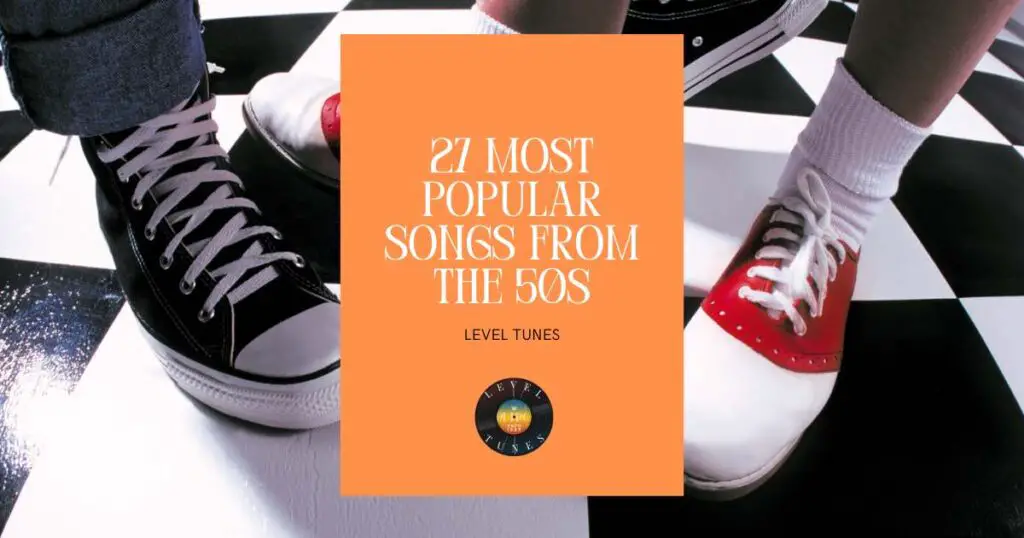27 Most Popular Songs From the 50s: Music Gems
Hey there, fellow music enthusiasts! It’s TBone here, from Level Tunes, your go-to DJ and music fanatic. Today, I’m absolutely thrilled to share something special with you all – a handpicked list of the 27 most popular songs from the fabulous 1950s.
Why the ’50s, you ask? Well, this era was a magical time in music history, marking the birth of rock ‘n’ roll and witnessing an incredible fusion of genres.
Each song on this list isn’t just a track; it’s a timeless masterpiece that shaped the music world as we know it.
Whether you’re a DJ looking to enrich your setlist or a music lover craving some nostalgic melodies, this list is your golden ticket to the heart of the ’50s sound. So, let’s turn back the clock and dive into the tunes that rocked the world!
Here are the most popular songs from the 50s that you can check out:
List Of Most Popular Songs From the 50s
Most popular songs from the 50s in a list format:
1. “Rock Around the Clock” by Bill Haley & His Comets (1954, Decca Records)
“Rock Around the Clock” is more than just a song; it’s a cultural phenomenon that signaled the birth of rock ‘n’ roll. Released in 1954 under Decca Records and featured in the album “Shake, Rattle and Roll,” this track by Bill Haley & His Comets became an anthem for a generation. Its infectious energy and pioneering sound made it a cornerstone in music history. The song’s driving rhythm, courtesy of Haley’s charismatic vocals and the band’s vibrant instrumentation, captured the spirit of the era. I chose this song for its historic impact and its role in shaping rock music.
2. “Johnny B. Goode” by Chuck Berry (1958, Chess Records)
Chuck Berry’s “Johnny B. Goode” is a masterclass in rock ‘n’ roll guitar playing. Released in 1958 under Chess Records, this song appeared on Berry’s album “Chuck Berry Is on Top.” The song tells the story of a country boy with dreams of stardom, reflecting Berry’s own journey in music. Its electrifying guitar riffs and Berry’s dynamic performance made it a symbol of the rock ‘n’ roll dream. This song is on the list for its influential guitar work and its representation of the American dream in music.
3. “Heartbreak Hotel” by Elvis Presley (1956, RCA Victor)
Elvis Presley’s “Heartbreak Hotel,” released in 1956 under RCA Victor, is a haunting ballad that showcased Presley’s unique vocal style. It was featured on his self-titled album, “Elvis Presley.” The song’s melancholic lyrics, combined with Elvis’s emotive delivery, struck a chord with audiences worldwide. It’s a track that highlights the King of Rock ‘n’ Roll’s ability to blend blues and rock, creating a sound that was both fresh and deeply soulful. I selected this song for its raw emotional power and Elvis’s groundbreaking vocal performance.
4. “What’d I Say” by Ray Charles (1959, Atlantic Records)
Ray Charles’s “What’d I Say,” from the 1959 album “The Genius of Ray Charles” and released under Atlantic Records, is a seminal work in the fusion of rhythm and blues and early rock. This song is a vibrant showcase of Charles’s dynamic piano playing and impassioned vocals. Its call-and-response style and infectious rhythm make it a standout track. “What’d I Say” is a testament to Charles’s genius in blending different musical styles, and it’s chosen for its innovation and its role in bridging the gap between R&B and rock.
5. “Tutti Frutti” by Little Richard (1955, Specialty Records)
Little Richard’s “Tutti Frutti,” released in 1955 under Specialty Records, is an explosive track that’s all about raw energy and wild abandon. Featured on his album “Here’s Little Richard,” this song’s frenetic pace and Little Richard’s distinctive, high-energy vocals were groundbreaking. Its nonsensical yet catchy lyrics and driving beat made it a staple of early rock ‘n’ roll. “Tutti Frutti” is included for its sheer energy and for showcasing Little Richard’s uninhibited performance style, which influenced countless artists.
6. “Hound Dog” by Elvis Presley (1956, RCA Victor)
“Hound Dog,” another gem by Elvis Presley, was released in 1956 under RCA Victor and later featured on the album “Elvis’ Golden Records.” This song, originally written for Big Mama Thornton, became one of Elvis’s most iconic tracks. Its upbeat tempo and Presley’s charismatic delivery transformed it into a rock ‘n’ roll classic. “Hound Dog” is a song that captures Elvis’s ability to reinterpret and invigorate existing songs, making them his own. It’s chosen for its role in showcasing Elvis’s versatility and his impact on the genre.
7. “Peggy Sue” by Buddy Holly (1957, Coral Records)
Buddy Holly’s “Peggy Sue” is a song that perfectly encapsulates the innocence and charm of the ’50s rock ‘n’ roll scene. Released in 1957 under Coral Records and featured on the album “Buddy Holly,” this track is a delightful mix of Holly’s clear, melodic vocals and a light, catchy rhythm. The song, with its heartfelt lyrics and Buddy’s signature vocal style, became one of his most beloved hits. “Peggy Sue” is included for its representation of the more melodic side of rock ‘n’ roll and for highlighting Holly’s unique talent in songwriting and performance.
8. “Great Balls of Fire” by Jerry Lee Lewis (1957, Sun Records)
Jerry Lee Lewis brought the house down with “Great Balls of Fire,” released in 1957 under Sun Records. This electrifying track, which featured on his album “Jerry Lee Lewis,” showcases Lewis’s fiery piano skills and wild, energetic vocal style. The song, with its driving beat and unforgettable chorus, became a defining moment in rock ‘n’ roll history. It’s chosen for its sheer energy, Lewis’s unparalleled piano performance, and its ability to get anyone’s foot tapping. “Great Balls of Fire” is a testament to the explosive power of rock music.
9. “Summertime Blues” by Eddie Cochran (1958, Liberty Records)
Eddie Cochran’s “Summertime Blues” is a 1958 rock anthem released under Liberty Records, featured on the album “Singin’ to My Baby.” This song, with its catchy guitar riff and relatable lyrics about teenage frustration, became a youth anthem. Cochran’s vocal delivery and the song’s simple yet effective structure made it a classic. It’s included for its representation of teenage life in the ’50s and for its influence on later rock and punk bands. “Summertime Blues” captures the spirit of rebellion that was central to rock ‘n’ roll.
10. “La Bamba” by Ritchie Valens (1958, Del-Fi Records)
Ritchie Valens redefined the rock scene with “La Bamba,” released in 1958 under Del-Fi Records and featured on his album “Ritchie Valens.” This song, a rock adaptation of a traditional Mexican folk song, showcased Valens’ talent for blending cultural influences. Its infectious rhythm and Valens’ energetic performance made it a groundbreaking track. “La Bamba” is chosen for its cultural significance and for highlighting Valens’ role in introducing Latin rhythms into mainstream rock.
11. “Blue Suede Shoes” by Carl Perkins (1956, Sun Records)
Carl Perkins’ “Blue Suede Shoes,” released in 1956 under Sun Records and later included in his album “Dance Album of Carl Perkins,” is a rockabilly classic that combines country with early rock. Its catchy lyrics and Perkins’ smooth yet energetic delivery made it a staple in the rock ‘n’ roll repertoire. The song’s enduring appeal lies in its ability to blend different genres seamlessly. “Blue Suede Shoes” is chosen for its influence on the rockabilly genre and its enduring popularity.
12. “Jailhouse Rock” by Elvis Presley (1957, RCA Victor)
“Jailhouse Rock,” another hit by Elvis Presley, was released in 1957 under RCA Victor and was a part of the soundtrack for the movie of the same name. This song is an exemplar of Presley’s ability to blend rhythm and blues with rock ‘n’ roll. Its catchy beat, memorable lyrics, and Elvis’ dynamic performance make it an unforgettable track. “Jailhouse Rock” is included for its iconic status in Presley’s career and for its representation of the rock sound of the ’50s.
13. “Maybellene” by Chuck Berry (1955, Chess Records)
Chuck Berry’s “Maybellene,” released in 1955 under Chess Records, is a pioneering rock ‘n’ roll song. Featured on his album “Chuck Berry Is on Top,” this track combines elements of country and R&B. Berry’s storytelling through lyrics and his distinctive guitar riffs made “Maybellene” a groundbreaking track in the evolution of rock music. It’s chosen for its innovative blend of musical styles and for Berry’s influential guitar work.
14. “All Shook Up” by Elvis Presley (1957, RCA Victor)
Elvis Presley’s “All Shook Up,” released in 1957 under RCA Victor and featured on his album “Elvis’ Golden Records,” is a vibrant display of Presley’s unique style. This song, with its catchy melody and Elvis’ charismatic vocal delivery, became a chart-topping hit. Its blend of rock ‘n’ roll with a hint of blues showcases Presley’s versatility as an artist. “All Shook Up” is selected for its catchy tune and for being a quintessential Elvis track that resonates with audiences even today.
15. “That’ll Be The Day” by Buddy Holly and The Crickets (1957, Brunswick Records)
Buddy Holly and The Crickets’ “That’ll Be The Day,” released in 1957 under Brunswick Records and featured on the album “The “Chirping” Crickets,” is a song that perfectly encapsulates the sound of early rock ‘n’ roll. Holly’s clear vocal delivery, combined with the band’s tight instrumentation, created a sound that was both innovative and timeless. The song’s catchy chorus and memorable melody made it a huge hit. It’s included for its
16. “Lucille” by Little Richard (1957, Specialty Records)
Little Richard’s “Lucille,” released in 1957 under Specialty Records and included on his album “Little Richard,” is a raw and energetic masterpiece. The song’s driving beat, combined with Little Richard’s powerful vocals and electrifying piano playing, makes it a standout track in rock ‘n’ roll history. “Lucille” captures the essence of the genre with its unrestrained energy and infectious rhythm. I chose this song for its pioneering sound and Little Richard’s unmatched performance, which has inspired generations of musicians.
17. “Yakety Yak” by The Coasters (1958, Atco Records)
The Coasters brought a unique blend of humor and rhythm to rock ‘n’ roll with “Yakety Yak,” released in 1958 under Atco Records and featured on their album “The Coasters.” This song stands out for its witty lyrics, catchy saxophone riffs, and the band’s playful vocal style. It’s a fun, upbeat track that reflects the lighter side of the ’50s music scene. “Yakety Yak” is included for its distinctive approach to rock ‘n’ roll and its ability to capture the joyful spirit of the era.
18. “Bye Bye Love” by The Everly Brothers (1957, Cadence Records)
The Everly Brothers’ “Bye Bye Love,” released in 1957 under Cadence Records and featured on their album “The Everly Brothers,” is a harmonious blend of country and rock ‘n’ roll. The song’s beautiful harmonies, catchy tune, and relatable lyrics about love and loss resonated with a wide audience. It showcases the Everly Brothers’ ability to bridge different musical styles seamlessly. I selected “Bye Bye Love” for its timeless appeal and its role in shaping the sound of harmony in rock music.
19. “Wake Up Little Susie” by The Everly Brothers (1957, Cadence Records)
Another hit from The Everly Brothers, “Wake Up Little Susie,” was released in 1957 under Cadence Records and appeared on their album “The Everly Brothers.” This song, with its engaging narrative and the brothers’ signature harmonies, captures the innocence and charm of the ’50s. Its catchy melody and playful lyrics made it a beloved track of the era. “Wake Up Little Susie” is chosen for its storytelling prowess and for exemplifying the unique sound of The Everly Brothers.
20. “Long Tall Sally” by Little Richard (1956, Specialty Records)
“Long Tall Sally,” released in 1956 by Little Richard under Specialty Records and featured on his album “Here’s Little Richard,” is a high-octane, fast-paced rock ‘n’ roll classic. Little Richard’s dynamic vocal range and the song’s rapid tempo set a new standard for the genre. The song’s raw power and energy make it an unforgettable track that still excites listeners. I chose “Long Tall Sally” for its groundbreaking speed and energy, which have influenced countless rock artists.
21. “Folsom Prison Blues” by Johnny Cash (1955, Sun Records)
Johnny Cash’s “Folsom Prison Blues,” released in 1955 under Sun Records and featured on his album “With His Hot and Blue Guitar,” is a powerful blend of country and rockabilly. The song’s deep, resonant vocals and storytelling lyrics paint a vivid picture of life inside Folsom Prison. Its haunting melody and Cash’s emotive performance make it a classic. “Folsom Prison Blues” is chosen for its storytelling depth and for showcasing Cash’s unique style within the rock ‘n’ roll genre.
22. “Don’t Be Cruel” by Elvis Presley (1956, RCA Victor)
Elvis Presley’s “Don’t Be Cruel,” released in 1956 under RCA Victor, is a song that embodies the King’s charm and charisma. Featured on his album “Elvis’ Golden Records,” the track combines a catchy melody with Elvis’s smooth, engaging vocal style. Its blend of rock and pop elements made it a massive hit. “Don’t Be Cruel” is included for its demonstration of Elvis’s ability to appeal to a wide audience and for its catchy, timeless quality.
23. “Whole Lotta Shakin’ Goin’ On” by Jerry Lee Lewis (1957, Sun Records)
Jerry Lee Lewis shook the music world with “Whole Lotta Shakin’ Goin’ On,” released in 1957 under Sun Records. This track, featured on his album “Jerry Lee Lewis,” is a prime example of Lewis’s explosive piano skills and charismatic stage presence. The song’s driving beat and energetic performance make it an essential rock ‘n’ roll anthem. It’s chosen for its vibrant energy and for showcasing Jerry Lee Lewis’s unique place in rock history.
24. “Chantilly Lace” by The Big Bopper (1958, Mercury Records)
“Chantilly Lace” by The Big Bopper, released in 1958 under Mercury Records, is a song that brought a playful and theatrical element to rock ‘n’ roll. Featured on his album “Chantilly Lace,” this track is known for its catchy chorus and The Big Bopper’s humorous, engaging vocal style. The song’s lively rhythm and memorable lyrics made it a standout hit of the era. “Chantilly Lace” is included for its unique blend of humor and rock, adding a different dimension to the genre.
25. “Only You (And You Alone)” by The Platters (1955, Mercury Records)
The Platters’ “Only You (And You Alone),” released in 1955 under Mercury Records and featured on their album “The Platters,” is a smooth, soulful ballad that stood out in the rock-dominated ’50s. The song’s beautiful harmonies, combined with its romantic lyrics, made it a timeless love song. The Platters’ ability to bring a touch of elegance to rock ‘n’ roll is why “Only You” is chosen, highlighting the diversity of music in the ’50s.
26. “Love Potion No. 9” by The Clovers (1959, United Artists Records)
“Love Potion No. 9,” performed by The Clovers and released in 1959 under United Artists Records, is a song that blends elements of doo-wop and R&B. Featured on their album “Love Potion No. 9,” the track stands out for its catchy tune and playful lyrics about a magical love potion. The Clovers’ smooth vocal harmonies and the song’s upbeat tempo make it a delightful addition to the rock ‘n’ roll era. I included it for its unique storytelling and its representation of the doo-wop style in rock music.
27. “Tequila” by The Champs (1958, Challenge Records)
Concluding the list with “Tequila” by The Champs, released in 1958 under Challenge Records and featured on their album “Go Champs Go!” This instrumental track stands out for its simplicity and infectious rhythm. The song’s memorable saxophone riff and the shout of “Tequila!” make it instantly recognizable. It’s a fun, energetic track that captures the spirit of the ’50s. “Tequila” is chosen for its distinctive sound and its ability to demonstrate the power of instrumental music in the rock ‘n’ roll genre.
Fun Facts: Most Popular Songs From the 50s
Fun Fact About “Rock Around the Clock” by Bill Haley & His Comets
“Rock Around the Clock” was not an immediate hit when it was first released. It only gained massive popularity after being used in the opening credits of the 1955 film “Blackboard Jungle,” which led to it becoming a teenage anthem and a symbol of the rock ‘n’ roll revolution.
Fun Fact About “Johnny B. Goode” by Chuck Berry
“Johnny B. Goode” is partly autobiographical, reflecting Chuck Berry’s own life. Berry, originally from St. Louis, crafted the song about a country boy who could play the guitar just like ringing a bell, mirroring his journey to stardom. This song was also one of the tracks included on the Golden Record aboard the Voyager spacecrafts, representing rock ‘n’ roll to potential extraterrestrial listeners.
Fun Fact About “Heartbreak Hotel” by Elvis Presley
The inspiration for “Heartbreak Hotel” came from a newspaper article about a man who committed suicide, leaving behind a note that simply read, “I walk a lonely street.” This poignant line caught the attention of songwriter Tommy Durden, leading to the creation of one of Elvis’s most iconic songs.
Fun Fact About “La Bamba” by Ritchie Valens
“La Bamba” is a traditional Mexican folk song, but Ritchie Valens’ adaptation was groundbreaking as it was one of the first times a song in Spanish hit the mainstream rock ‘n’ roll charts in the United States. Valens, who was only 17 at the time, brought a new cultural dimension to rock music.
Fun Fact About “Hound Dog” by Elvis Presley
Elvis Presley’s rendition of “Hound Dog” was actually a cover of a song originally recorded by Big Mama Thornton in 1952. Elvis’s version was more upbeat and differed significantly in style from Thornton’s original blues number, showcasing his ability to transform and popularize existing songs.
Fun Fact About “Peggy Sue” by Buddy Holly
“Peggy Sue” was originally titled “Cindy Lou” after Buddy Holly’s niece, but it was later changed to “Peggy Sue” in honor of Peggy Sue Gerron, who was the girlfriend (and later the wife) of Jerry Allison, the drummer for Holly’s band, The Crickets.
Fun Fact About “Great Balls of Fire” by Jerry Lee Lewis
“Great Balls of Fire” was recorded in a single take. Jerry Lee Lewis’s energetic performance and piano skills were so intense that no further takes were considered necessary. This song also caused some controversy at the time due to its perceived “wild” nature and suggestive lyrics.
Fun Fact About “Summertime Blues” by Eddie Cochran
“Summertime Blues” was unique for its time due to its teenage perspective on work, life, and leisure. The song’s co-writer and performer, Eddie Cochran, was only 19 years old when he recorded it, making him a true voice of the youth of that era.
Fun Fact About “Blue Suede Shoes” by Carl Perkins
“Blue Suede Shoes” was the first song to hit the top 3 on the Pop, R&B, and Country charts simultaneously, reflecting its wide appeal across different musical genres. Interestingly, this song was later famously covered by Elvis Presley, but it was Carl Perkins’ original version that achieved this unique chart-topping feat.
Fun Fact About “Jailhouse Rock” by Elvis Presley
“Jailhouse Rock” was featured in the movie of the same name starring Elvis Presley. The iconic dance sequence in the film, choreographed by Alex Romero, was highly innovative for its time and is often considered one of the best dance sequences in the history of musical cinema.
And there you have it, music lovers! A journey back to the roots of rock ‘n’ roll with 27 timeless classics from the 1950s. These songs not only shaped a generation but also laid the foundation for the musical marvels we enjoy today. Keep rocking to the timeless beats of the ’50s!
Thanks for reading.
TBone




